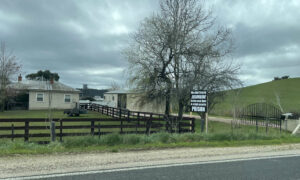St John’s “is a living history of the lives of the people of Franklin and of Tasmania”, wrote Pat Lee
Last call to the faithful
The last congregation

It was sad enough to be sitting in Franklin’s St John’s Church on Sunday afternoon and knowing that the service in progress would culminate in the deconsecration of this 19th-century house of God.
Worse was to come. As the last rites were enacted, priest-in-charge Reverend Peter Lindenmayer revealed to a congregation of about 25 believers that, when St John’s members had arrived at the church the previous Wednesday afternoon (August 6) to prepare it for deconsecration, they had found the padlock glued up. It was a situation that required the services of a borrowed cordless grinder.
Even worse was to come. The priest went on to say that, on gaining entry to the church, it was discovered that a variety of items had disappeared, including “the bishop’s chair” (which had stood in the church for 150 years), the altar cross, two candle stands, a brass collection plate, an altar lectern, a wooden collection plate and more. He said they had been stolen, and that the theft would be reported to the police. (On Monday, Peter Lindenmayer told me that his reaction last Wednesday had been “disbelief, it stunned me, it was so targeted”).
Even to this non-believer, the priest’s announcement during the deconsecration service was shattering. What kind of low life, I pondered, could have even contemplated, let alone engineered, a theft so obscene? Whether you are believer or not, the items listed were sacred by being in a sacred place. And sacred places deserve the respect of everyone. That’s the only way societies with disparate components can live in harmony.
Outside, bitter winter — back with a vengeance yet occasionally softened by moments of stillness and fleeting shafts of sunlight — battered this ancient monument to a now much-diminished trust in an almighty power. Across the swollen Huon, snow was settling at not much above 200 metres. Surely, such bleakness was not a message to the converted that St John’s was being ritualised into a godless future?
THE deconsecration service over, one of the few locals in the sparse congregation confided that most of those present hailed from Ranelagh, perhaps 10 kilometres upstream and headquarters of the Anglican Church in the Huon Valley.
Was it irony that an Anglican church in Franklin was being stripped of its holiness at just about the same time that a new Catholic church was being blessed in Ranelagh? Not at all. It was more a case of a rough coincidence: within a few years of each other, both Catholic and Anglican institutions had realised that, at least in Franklin, they had run their race. They had run out of congregations — and an idle church, like any other substantial property, is not cheap to run; and each had decided to abandon most of their consecrated Franklin premises. Ranelagh, today, is where both churches seem to be pinning their hopes on a sometime resurgence of Christian faith in the Huon.
WITH both churches in Franklin in retreat, a small band of locals (perhaps some with faith and some without) began working to establish a ‘Friends of St John’s Franklin’. On Wednesday this week (August 13) at 7pm, they will be holding a meeting at The Palais, Franklin, to ratify a proposed constitution and elect office bearers.
The intention is to acquire St John’s on behalf of the community. (It seems certain the Anglican Church will want to sell it.) Pat Lee, one of the group, wrote in the Huon Valley News (August 6): “St John’s . . . was more than just a place of worship and a cemetery. It is a living history of the lives of the people of Franklin and of Tasmania . . . All members of the Franklin community or supporters of what the Friends of St John’s Franklin are trying to do are welcome to attend [Wednesday’s meeting].
Pat Lee also wrote: “A business plan for the use of the building and its land [said to be about 1.2 hectares including the cemetery] will need to be urgently developed. We have had a lot of suggestions for [the church’s] use, from a museum, art space, community garden and a wedding centre to a music venue . . .”
In gleaning information for this article, this writer sensed that there is a much more complex story behind the end of one of God’s structures in Franklin, and behind the visions and strategies of various people who would like to deal variously with the now deconsecrated St John’s.
An accurate story may one day be revealed. Perhaps it is a job for someone with the same eye for fine detail and indefatigability as were displayed by local resident Ruth Young in her long search for the story behind the history of The Palais, another fine Franklin structure, a building that was saved from council-hired bulldozers a couple of decades ago.
IT WILL be interesting, in the meantime, to see what price is put on the deconsecrated St John’s; how much is needed to restore the building to a state in which it would be ready for public functions; and, most importantly, how much enthusiasm there is in the community to support the vision of St John’s friends.
Pat Lee, in her letter to the Huon Valley News, wrote: “If you care about retaining this building for community use, please attend [the deconsecration]. Even if you just stand outside as a show of support for the community acquisition of the building it could really have an impact and would show that the Franklin community really cares.”
With no one standing with me under the church porch when the deconsecration service began, and with wind and rain lashing the stone and iron of this grand old church, I was not feeling at all uplifted, and certainly not optimistic about its friends’ hopes.
But perhaps Wednesday evening’s meeting at The Palais will confound non-believers and believers alike by laying the groundwork for the resurrection of a fine example of Victorian architecture that could play a valuable role in supporting the ever-reviving sense of community in Franklin as well as the wider economic interests of the Huon Valley, a region forever battling to meet the challenges of the 21st century. — Bob Hawkins
EARLIER on Tasmanian Times:
• Pat Lee: It would be a tragedy is this icon of the Franklin village …



























